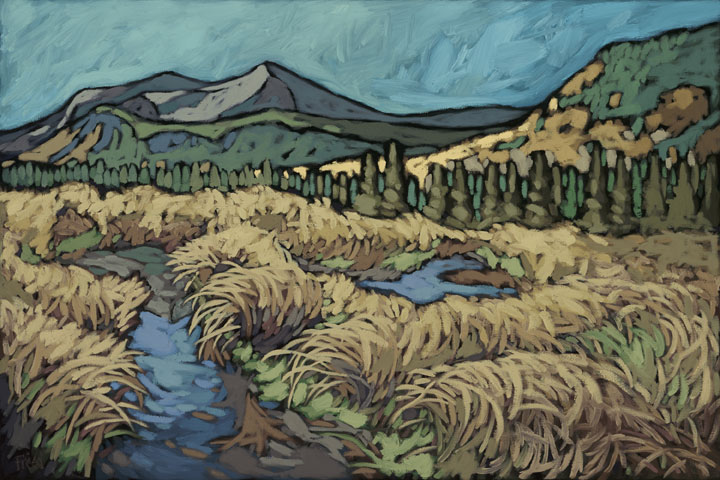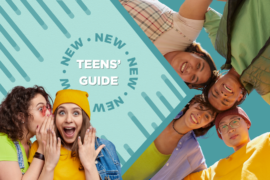On this week’s episode
- On this week’s episode of You Have a Cool Job, we talk with fine artist Adam Freed. Adam describes the path he took before he began selling his art.
- He explains the ways his business and venue scene has changed as the market has shifted, as he used to sell his paintings all over the state, but now sells more locally.
- Adam also shares some of his process in creating the art itself. Adam paints landscape oil paintings of mostly warm-weather scenes, but he creates these paintings in the winter and bases the pieces off of photographs he has taken.
About the show
You Have a Cool Job is a podcast hosted by Taylor Sienkiewicz from Peterson’s. The show highlights professionals who have a unique, interesting, uncommon, or otherwise cool job.
Our goal is to motivate you and show how interesting, fulfilling, and anything-but-average your career can be, and we’ll do this by talking with people who took a path less traveled. We ask these fascinating individuals how they got to where they are in their career based on their education, experience, and influences; why they love their job; and lots more.
Want more?
If you like what you’re hearing, check out these resources to get plugged in.
For more episodes of You Have a Cool Job, visit our YouTube channel. View other podcast blogs here.
Subscribe to receive an email containing each podcast episode of You Have a Cool Job as they’re released.
Learn more about Adam’s work here.
Have a nomination for the show? Drop a line here.

Episode 10 Transcript
HOST SHOW INTRO: Welcome to the show! From Peterson’s, I’m Taylor Sienkiewicz, and you’re listening to “You Have a Cool Job”, a podcast highlighting those who took their profession in a unique direction, and what they did to get there.
THEME MUSIC
HOST INTRO: On today’s episode of You Have a Cool Job, we talk with someone who has a career we’ve all heard of, but probably don’t know a lot about how it works today. Adam Freed is a fine artist who creates landscape oil paintings to sell through his local art gallery and art festivals.
HOST (LIVE): So Adam on a day-to-day basis what is your job as a fine artist look like?
ADAM FREED: Well that is a tricky question to answer because my job even though yes I make my living as an artist my job never really looks exactly the same from day to day even from year to year I mean there might be I work out of a my Studios in my home I work out of an extra room in my home so I’m uh I work from home and you know I’m there might be days when I can devote an entire day to just being in my studio and painting but you know there are other days when you know for example and the Vice President on the board of a local art organization called artists of Crested Butte so on this particular day before getting into the studio I went at a board meeting but from year to year it changes to I you know there was a time when I had let a bit of a gypsy life gypsy kind of life I traveled all around the state of Colorado and I made in almost entirely all of my my sales from participating in our festivals.
HOST: During this nomadic time, Adam would attend 8 to 10 festivals throughout Colorado during what Adam says is the on-season of selling art–the warmer months when there are outdoor art festivals. Adam also is married and has two children. He said that during this time, his family would go with him to many of the festivals and make little vacations out of the trips. He describes this way of life.
ADAM FREED: So we’d set up my booth at the event and I hunker down and try and peddle my wares for the weekend and my family would you know play tourist and they’d go out and see the sights and then in the evenings when the event was over we’d go have dinner and you know it was actually a really fun and memorable part of my life is trying to figure out how to make a living as an artist.
HOST: However, after several years of this, the art festival market started to change and Adam found he couldn’t sell as much as he could before. So, Adam decided to switch his direction.
ADAM FREED: Here in the little town where I live in Colorado crested in Crested Butte I’d say over the last decade or so this little town has really turned itself into a fantastic little art market so my focus started to change to you know looking more closely at what I can do locally here and getting involved local organizations and seeing you know what the galleries could offer me here but also what local market events local festivals art festivals could offer me as well
HOST: As for what this community market looks like, Adam again described an on and off season with more selling art at markets and galleries in the warmer months and doing the actual painting in the colder months.
ADAM FREED: Every Sunday there is a local art market that has really sort of come into its own so for the past few years I have really thrown myself into making sure that I am out there every Sunday participating in that particular event and then when the summer season is through then I move a few of my pieces into the gallery Roth had the pleasure to be working at fur for a while now.
HOST: That is Adam’s current venue scene but he then describes his timing for the actual making of the art.
ADAM FREED: I actually tend to do most of my painting during the winter because during the summer I try and get myself out there and make myself as visible as possible and do as many of these venues and events as I can to try and sell my paintings and it works out well too because my boys well one of my oldest son is going off to college now but his younger brother is here but so the cycle is pretty much still the same the kids when they’re out of school you know when I’m out there trying to sell my paintings and then in the fall when the kids go back to school I go back into my studio.
HOST: When you picture the creation of landscape paintings, an image of an artist with a giant easel sitting in a field may pop into your head. However, Adam works with photographs he takes in the warm months so he can paint during the winter.
ADAM FREED: I am a studio artist I work mostly from photographs and drawings
that have done on location occasionally I’ll go out and paint plein air I’ll paint something on location but mostly I work from photographs here in my studio so during the winter time you know ideally my inventory has been depleted and so I get back into the studio and I
try and build that inventory back up and if I’m lucky enough my efforts during the summer season which is when I make I would say 80% of my sales during that summer season it’s I usually am able to secure a commission or two which is kind of nice to kind of ride me through what we call the offseason we have here in Crested Butte we have two very distinct offseason there’s a there is a down time in the fall and then there is a down time in the spring after the ski resort closes.
HOST (LIVE): Definitely. So another thing I’ve been noticing talking to different people like you with these sort of creative entrepreneurial entrepreneurial blended careers it’s like blended with
business which are two different head spaces a lot of times so how do you switch over between those?
ADAM FREED: Right well the first thing that I’ll mention in that regard is that my business would be an utter chaos if it wasn’t for my wife she works for a local bookkeeper here in town and she also handles a lot of the numbers and business side of of what I do I do think that in terms of when I’m actually out there at a an event trying to sell my paintings I do think that there is something I don’t know if it’s from a business point of view it’s more of a people point of view where I think you have to be able to talk a little bit about your artwork and yourself and you have to be able to make connections with people I think that is important and I actually enjoy that part of of what I do and I think that if someone is interested in buying a piece of artwork I think that meeting the artist the person that created that piece of artwork certainly goes a long way so being open and receptive to you know Ted to having conversations with people is is actually really important and that’s actually a really good question because yes it’s important that you know you are creating these it’s important to me that I’m creating these paintings but you’re right you have to get out there and you have to figure out you have to connect these paintings with potential buyers.
HOST (LIVE): Right it’s kind of an introvert extrovert type of thing. And then Adam how did you get started as an artist?
ADAM FREED: Well my you know my earliest memories from childhood you know they all revolve around making art creating things so you know it was always just something that I did and you know when I was younger it was kind of my you know my my fallback my therapy and I honestly it’s my place of sanity still to this day as an adult but so I was I always had an innate interest in making art and like most things that you know you have a strong interest in it you’re going to keep doing it and you know you think that over the course of time your your skills at whatever that that thing is that is of interest to you your skills will improve and you know so I just did this for fun for the for a long time just something for myself but when I went to college so I didn’t really have a clear idea of what I wanted to do with this interest that I had an art so
I started out as a design major when I was in college and but eventually I started to realize that I would always be creating art for somebody else and so there was a side to me that was a little more selfish than that I wanted to be creating for my own pleasure so I started mixing my design classes and was just some studio classes painting drawing that kind of thing then I don’t even think things came into focus at the collegiate level for me until I was you know late my sophomore year I I took an education class and I ended up graduating with a Bachelor of Science in art education.
HOST: Adam took this degree to Florida and taught elementary school art for about four years before he decided he wanted a change. He left Florida and traveled around Europe for awhile, then returned where he decided to venture out to Colorado, where he met his now-wife.
ADAM FREED: So she and I both had this idea that we should open up an arts and craft supply store here in Crested Butte which there was nothing like that at the time and so we opened up this store and ran it for about eight years and it was during that eight-year period here in Crested Butte that we were running this little business that I was still painting just again at this point just for fun and I decided maybe I’ll bring some of my paintings in and just hang them on the walls in this little arts and craft supply store we called it the creation station so I brought my my paintings and then hung them in the creation station and people started buying them so that’s when I sort of got this idea that I’ve I’ve taught art and I’ve been running and a business that sells art supplies and I’ve been painting this whole time and like I said from as far back as I can remember always creating art maybe now is the time to try to see if I can actually make a living selling these paintings that I love to make so that’s where that all sort of started for me and and like I said that kind of brings me up to to speed to where I am now I’ve been kind of pecking away at this and getting a little better at it I like to think in terms of selling and making art for the last 25 years.
HOST (LIVE): Right and also you mentioned college did you go to art school or regular college?
ADAM FREED: I went to Buffalo State College in upstate New York it wasn’t an art specific school but and it had a strong education program which I think is but you know was good that I got involved at that time in my life in and the idea of teaching or and I think that I I don’t really I don’t have any regrets about any of the choices that I made along the way because I think that you know sometimes you have to to make one choice to turn you in another direction and then eventually you know that choice leads to another and and I feel like I’ve sort of been narrowing
this focus for the last few decades now and you know there’s I you know I feel very blessed I feel very fortunate to be able to wake up every day and you know make make a living at doing something that I love to do.
HOST (LIVE): Yeah and then why did you go into specifically make landscape paintings instead of something else?
ADAM FREED: That’s actually a great question I think it’s mostly because of the
response that I have had childhood till now to my surroundings.
HOST: Adam shared his experiences as a child in upstate New York and recalled many childhood memories of wandering through forests and fields.
ADAM FREED: My appreciation for natural beauty was was taken to some other level once I found my place here in Colorado so I think I’ve always had this strong connection to the outdoors and to nature and no transitioning it sounds weird but transitioning from upstate to upstate New York to Crested Butte Colorado other than like I said that the scale of things and the sheer majesty out here you know it’s not it wasn’t like a huge departure it wasn’t like I was coming from big some big city moving to this little 8 block town in the middle of the mountains in Colorado I still had I grow up with me already this appreciation for nature so I think it’s I think it’s all of that combined that sort of drives me to paint landscapes but I you know I’m not opposed to including figures in my in my paintings and like I said a lot of my paintings aren’t just pure landscape they do have buildings there might be some scenes with towns and things like that and but I I think that there is something that is you know some deep connection for me as far as you know painting nature.
HOST: Adam has been painting his whole life and has been selling his paintings for 25 years now with this in mind the advice he received years ago that keeps him going may surprise you.
ADAM FREED: One of the best pieces of advice that I ever got was from a
friend of mine here in Crested Butte who was a different gallery owner than the one that I work at but many years ago she said to me when she first saw me out there and trying to make a go of this she said ok I’m gonna give you some advice she said just keep painting and I’m like well of course I’m gonna keep painting what kind of advice is that and to this day I actually think that is something that many people don’t understand and that it you have to commit and it is hard to stay on track at least for me I’m just talking from my own perspective it may be it’s something that people might not think about for me they might just think that I’m just happily painting along every day but but life has and I don’t want to say distractions because it’s not really like that life has other I have other obligations there are other things that other responsibilities that must be attended to and to stay on track with your painting as is actually challenging for me like I said this morning I’m out the door for a meeting I find out yesterday that my my battery is dead in one of my in my vehicle so that has to be attended to there are kids that are in school and like I said these are joys of my life that you know I happily partake in but you you have to find a balance between all of the other things that go on in everyday life and all of your other responsibilities you have to find the balance between that and carving out that time for you to paint
because for me it is a process yeah I have to be in my space here in my studio I have to have you know all my little creature comforts going I have my music I have my I have my palette here with all its colors on it so you know I kind of have to get in this place where my mind is going to be ready to paint but there but there always are these these things that you have to tend to in your everyday life but that is all part of it and I think that is and finding that balance and finding a way to make all of that work is as much a part of anything you know it’s like I’m not just an artist but I’m an artist trying to be a family man a father what a husband and I’m trying to you know I’m trying to to incorporate all of these elements together so that’s kind of maybe what I think is that people think that I’m just happily painting along but I’m actually it’s it sounds weird but it’s a battle to get to the easel for me yeah I constantly I have to fight for that time
HOST: As you may expect a certain focus and energy is important for an artist and something Adam has to be conscious of.
ADAM FREED: Pressure for me is not conducive with the creative place that I want to be so yeah you know and maybe sometimes I’m only able to get in my studio and paint for an hour or two but other times then maybe I can just devote an entire day which is bliss just being in your painting so you know it’s yeah it’s kind of like that you kind of have to keep your your head in the right place and you kind of have to keep yes it you have to be a little organized which again there’s an old thing you’re trying to organize artist is sort of like trying to herd cats but you know my again my wife really helps me with the organizational aspect of my life and so yeah it’s it’s always a challenge to kind of keep that all together.
HOST OUTRO: Painting is an art form we all know and love, but the modern-day version of the career of painting is something we don’t see all of the behind the scenes aspects of. We hope you’re inspired by Adam’s story and enjoyed taking a look into an artist’s studio. Thanks for tuning in, we’ll see you next week.
THEME MUSIC
Transcript generated by YouTube.


